Hall of Honor, (old) International Bluegrass Music Museum, Owensboro, KY.
Part of the mygrassisblue.com #BluegrassTrails series, on the trail of bluegrass history and its pioneers/early protagonists.
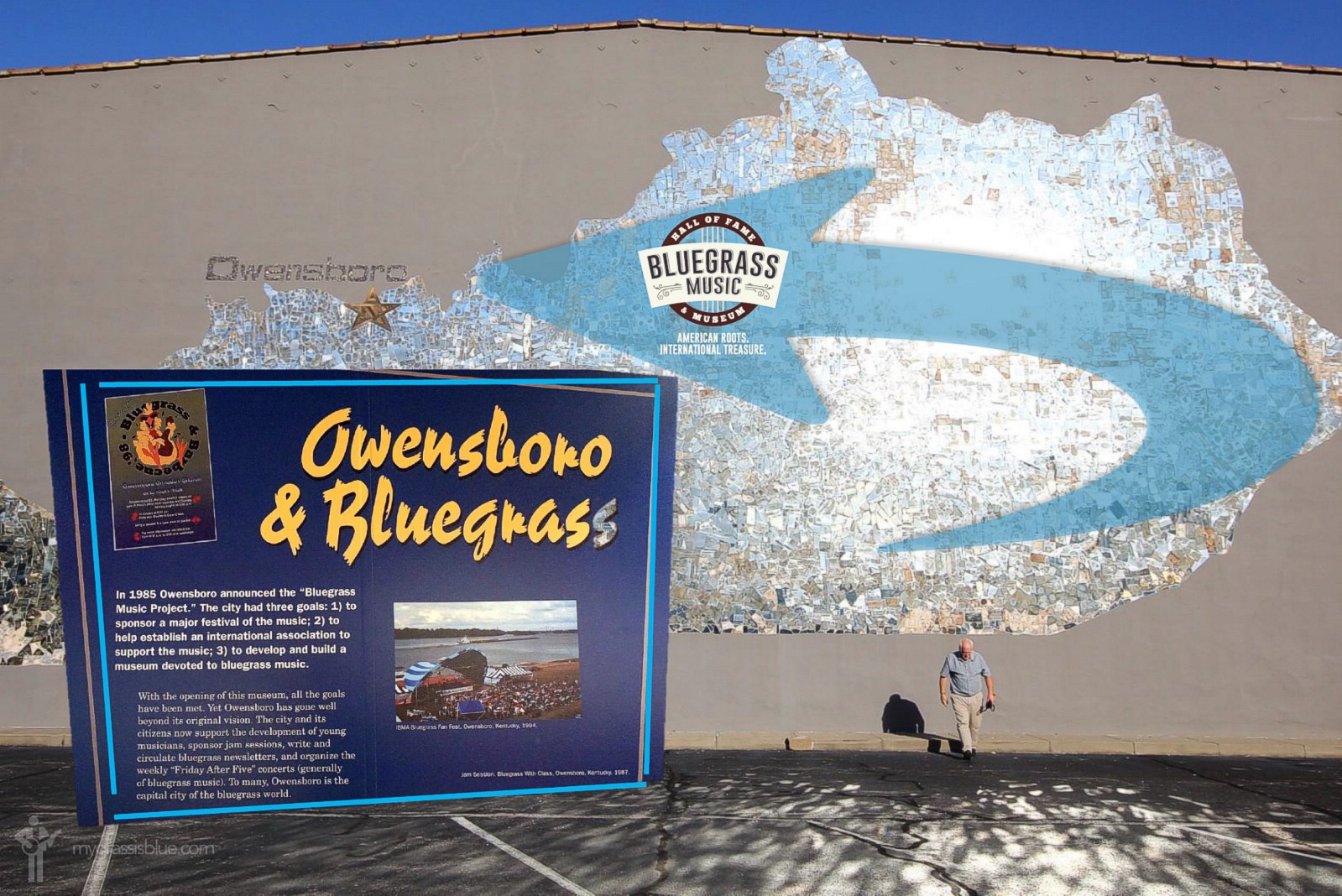
OWENSBORO & THE ‘BLUEGRASS MUSIC PROJECT’ | Dazzling. Owensboro, KY. September 28, 2016.
Dazzling Owensboro. Dazzling Kentucky. Kentucky was just as photogenic as we expected it to be, and a tough place to escape from – even when trying to leave the state we were pulled back for yet more eye candy. This massive and blindingly awesome mirror mural of the state of Kentucky caught our attention when crossing the very blue Glover Cary Bridge / Owensboro Bridge over the Ohio River out of town, and out of the bluegrass state of Kentucky, towards the state line with Indiana. It necessitated an about-turn and a re-entry into Kentucky for a closer inspection. Owensboro’s bluegrass bona fides will never be in question: the genre’s global trade association, the International Bluegrass Music Association (IBMA), had its initiation in the city in 1985; the city stages the annual multi-day Romp Festival (which celebrates ‘the roots and branches of bluegrass’, first festival in 2004); and the city is the proud home of the Bluegrass Music Hall of Fame & Museum (announced in 1988, incorporated in 1991 and opened year-round in 1995). All three goals were part of Owensboro’s 1985 ‘Bluegrass Music Project’, the successful completion of which both forever solidifies the city’s ties to the bluegrass community and may just give Owensboro a legitimate shout at being called ‘the capital city of the bluegrass world’.
– www.bluegrasshall.org
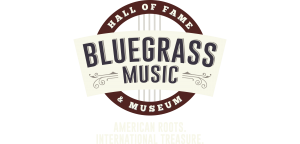 The only museum of its kind in the world, Owensboro’s Bluegrass Music Hall of Fame & Museum is, not surprisingly, dedicated to telling the story of the relatively short history of the bluegrass genre, the instruments at the core of its unique sound, and the gifted musicians who have brought the music to life and shaped it down through the years.
The only museum of its kind in the world, Owensboro’s Bluegrass Music Hall of Fame & Museum is, not surprisingly, dedicated to telling the story of the relatively short history of the bluegrass genre, the instruments at the core of its unique sound, and the gifted musicians who have brought the music to life and shaped it down through the years.When we visited the (old) museum in late 2016 — when it was called the International Bluegrass Music Museum — it was a somewhat claustrophobic affair tucked away in a corner of the city’s RiverPark Center; the old museum, incorporated in 1991, was the result of a late 1980’s joint venture between the IBMA and the RiverPark Center. Plans were afoot then for a late-2018 move to a bigger and better location only a short walk down 2nd Street from RiverPark Center. A whole city block, between South Elizabeth Street and Frederica Street and near the banks of the Ohio River, had been given over to the what was going to be a swanky and much-anticipated upgrade. And now it’s here.
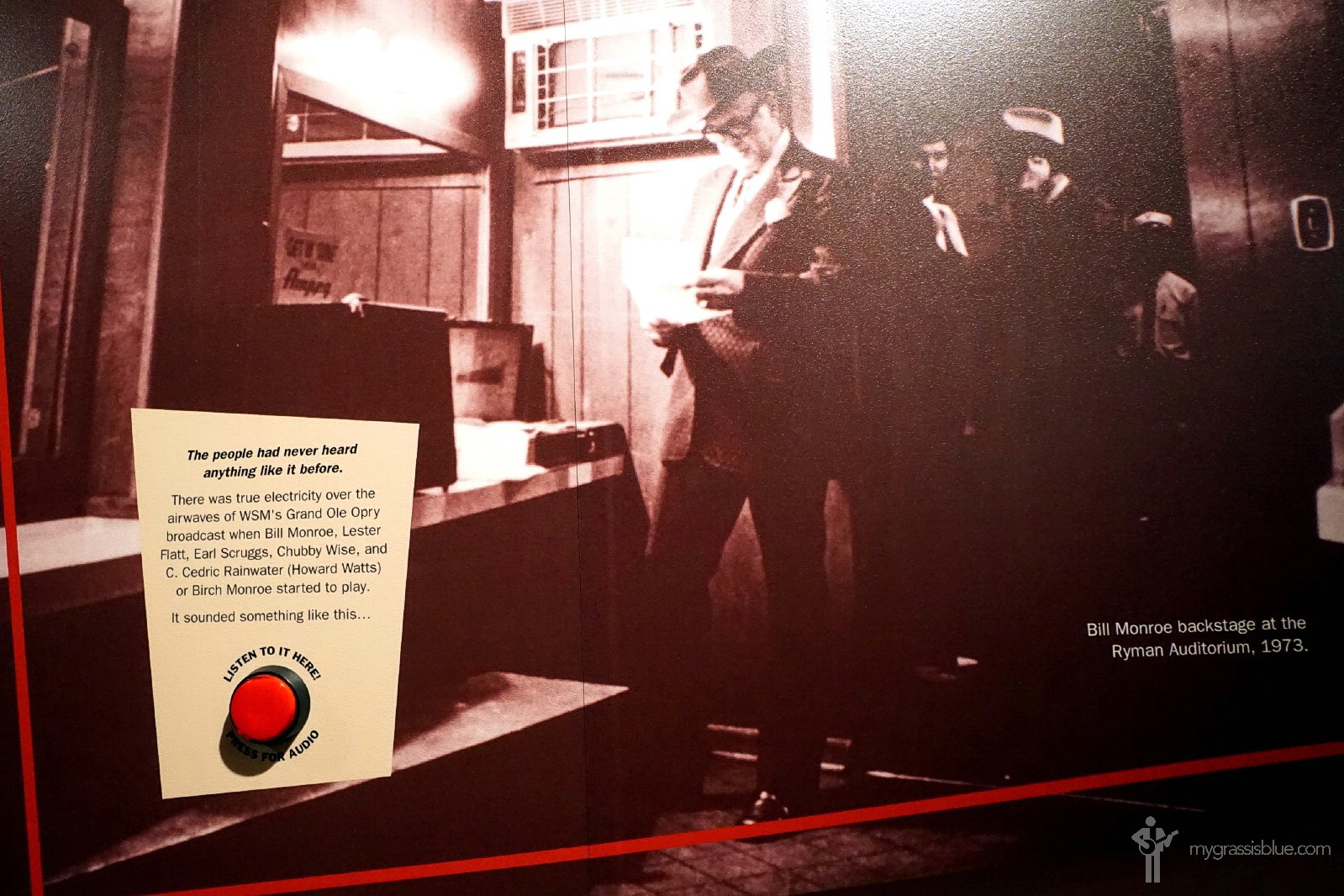
‘THE GRAND OLE OPRY’ | Bluegrass Music Hall of Fame & Museum, Owensboro, KY. September 28, 2016.
– Sam Bush commenting on the new Bluegrass Music Hall of Fame & Museum
– www.bluegrasshall.org

Bluegrass Music Hall of Fame & Museum, Owensboro, KY. September 28, 2016.
Museum Exhibit Overview
The Roots & Early Years
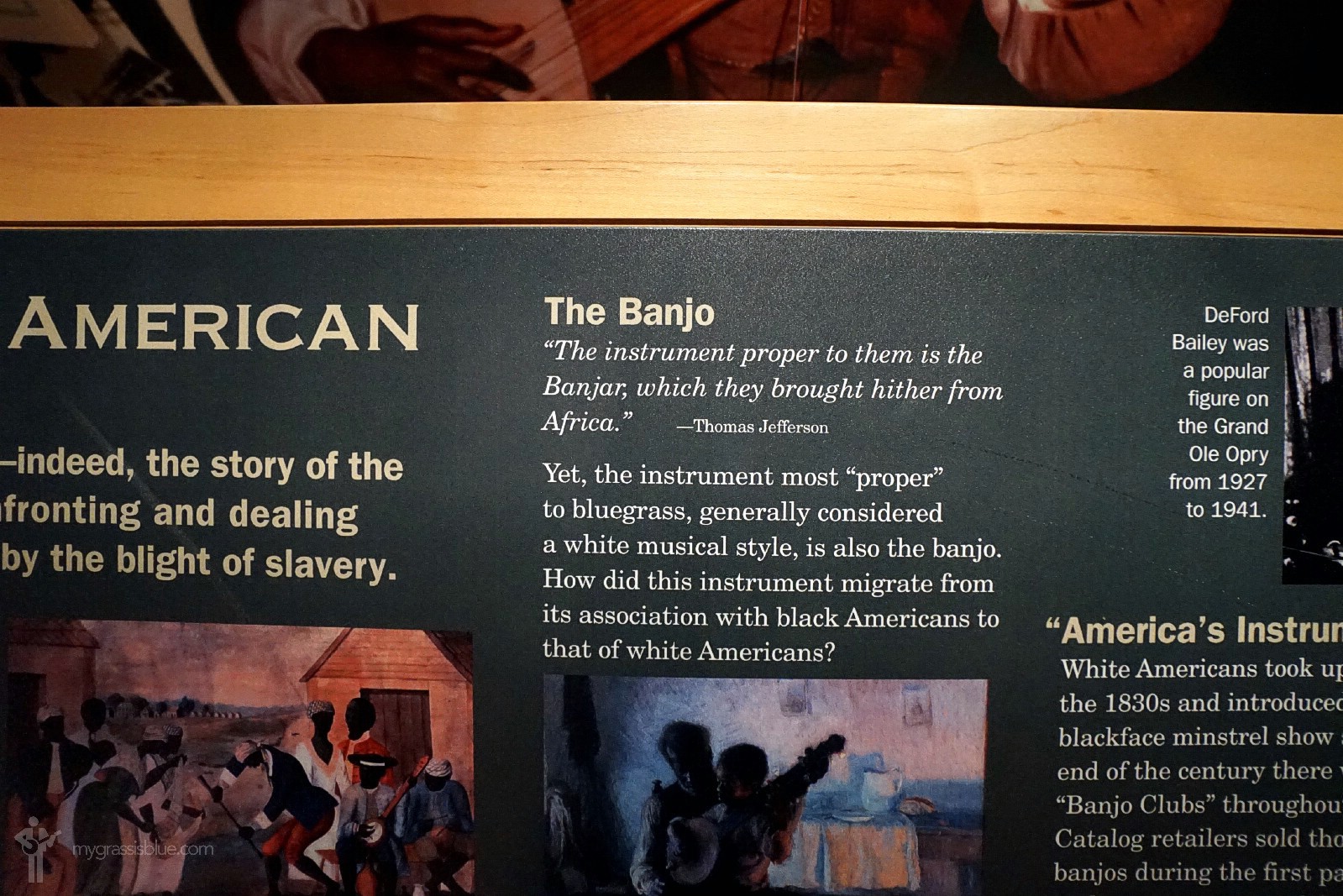
BANJO / BANJAR | ‘Cultures & Influences’ exhibit, Bluegrass Music Hall of Fame & Museum, Owensboro, KY. September 28, 2016.
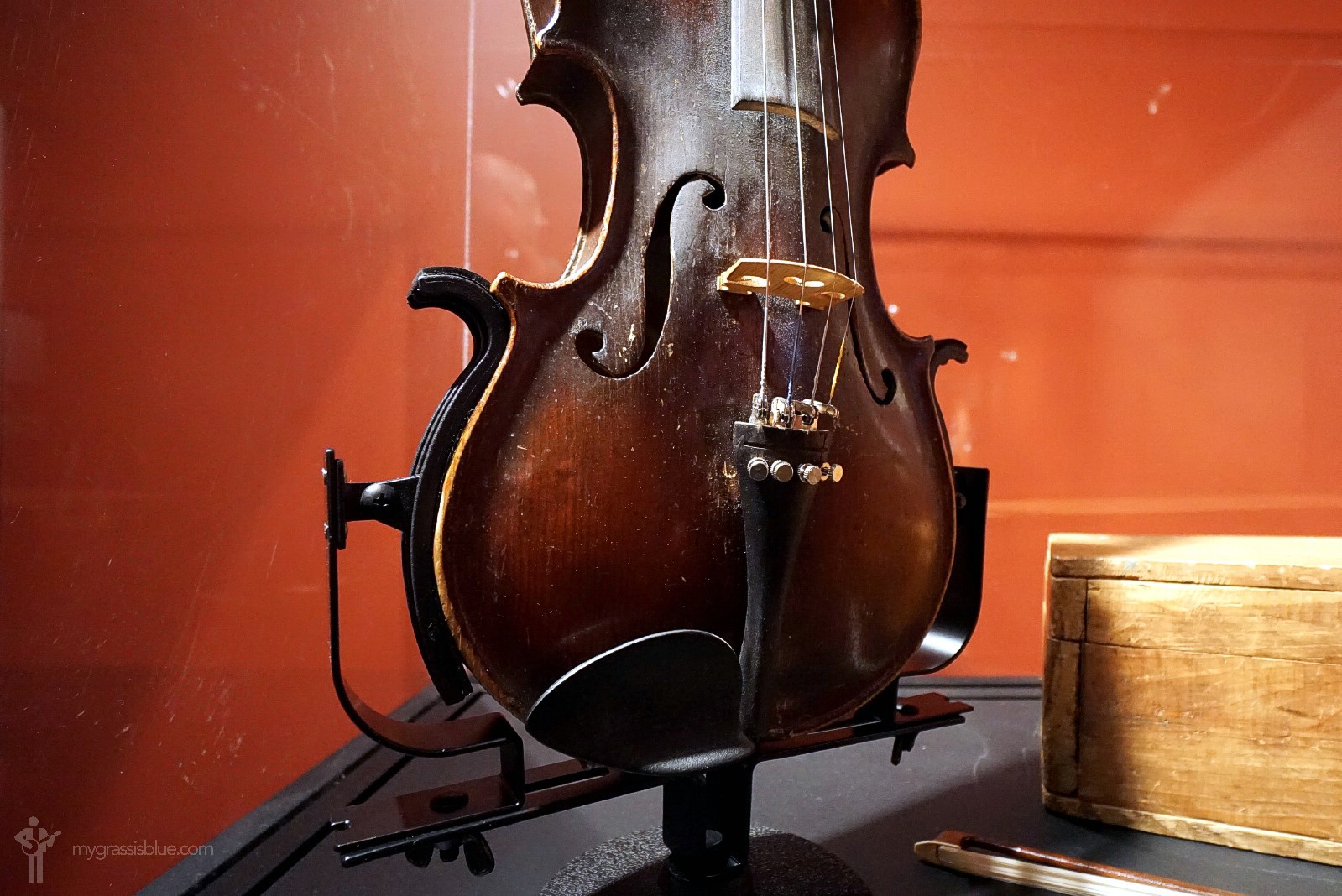
UNCLE PEN’S FIDDLE | Bluegrass Music Hall of Fame & Museum, Owensboro, KY. September 28, 2016.
Originally part of the Bill Monroe Centennial Exhibit, Uncle Pen’s fiddle is now on permanent display in the museum, although information on how the museum came to be in possession of one of the most famous instruments in the annals of the bluegrass story is curiously lacking. As highlighted in our dedicated Bill Monroe | Rosine, KY, entry, the renowned fiddler James Pendleton Vandiver, aka Uncle Pen (1869-1932), is a now legendary figure who provided a massive positive influence on a young Bill Monroe when growing up in rural Rosine. Nephew Bill would credit his Uncle Pen, who he famously immortalised in a song of the same name, with instilling in him the all-important ability to keep time when playing music. Bill’s mother Malissa, Uncle Pen’s sister, died when he was nine and his father passed away when he was sixteen. Hard times in the late 1920s eventually drove the rest of the Monroe siblings (Bill Monroe was the youngest of six sons and two daughters) north to Indiana to seek employment, but Bill stayed behind for two years and lived with Uncle Pen in his cabin on Jerusalem Ridge. These two years, from his sixteenth until his eighteenth year, proved to be the most crucial to Bill’s musical training. The rest, as they say, is history.
– Bill Monroe commenting on his Uncle Pen
THE ’60S ONWARD
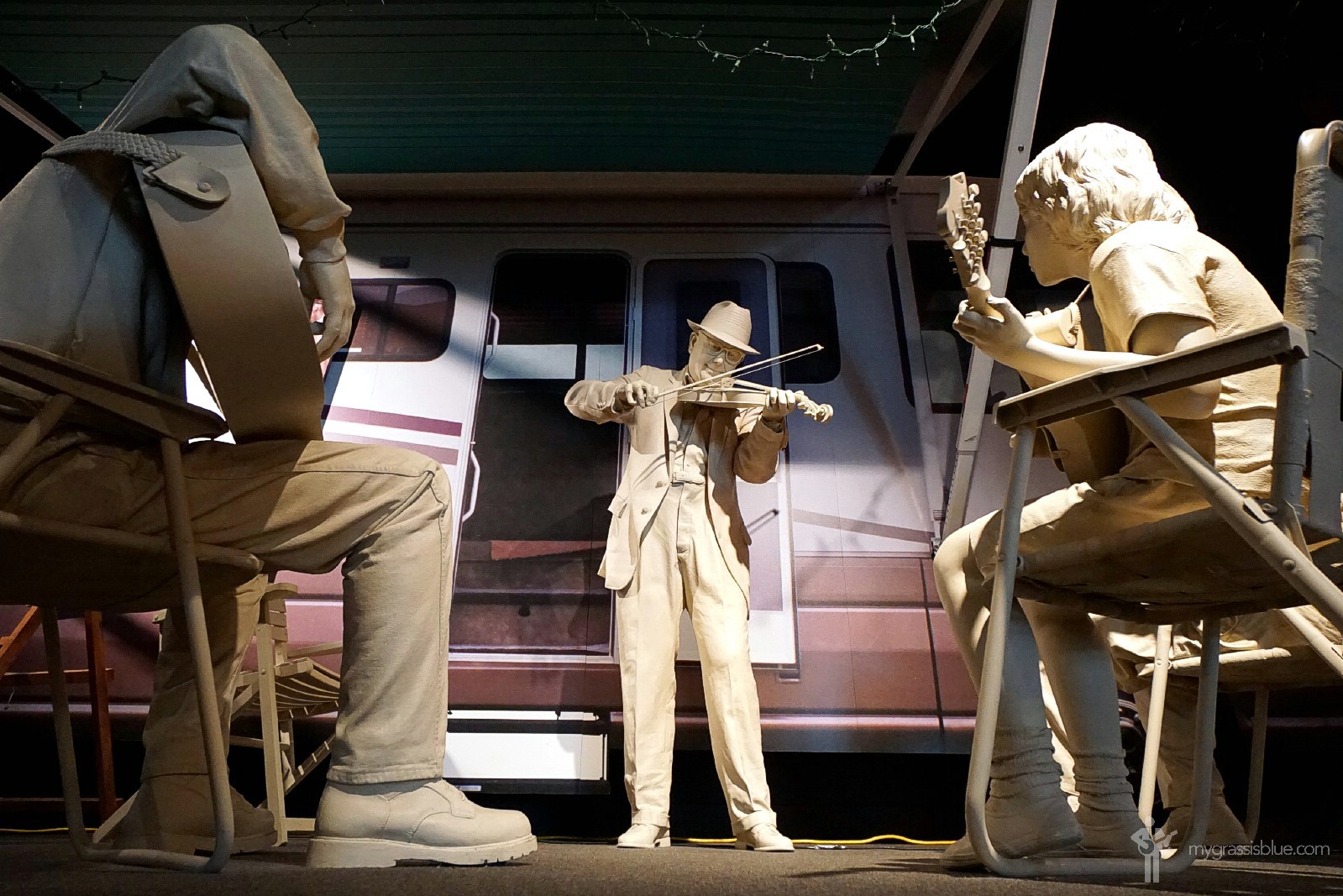
‘FESTIVALS‘ | Festival jam mock-up in the Bluegrass Music Hall of Fame & Museum, Owensboro, KY. September 28, 2016.
Other Select Exhibits
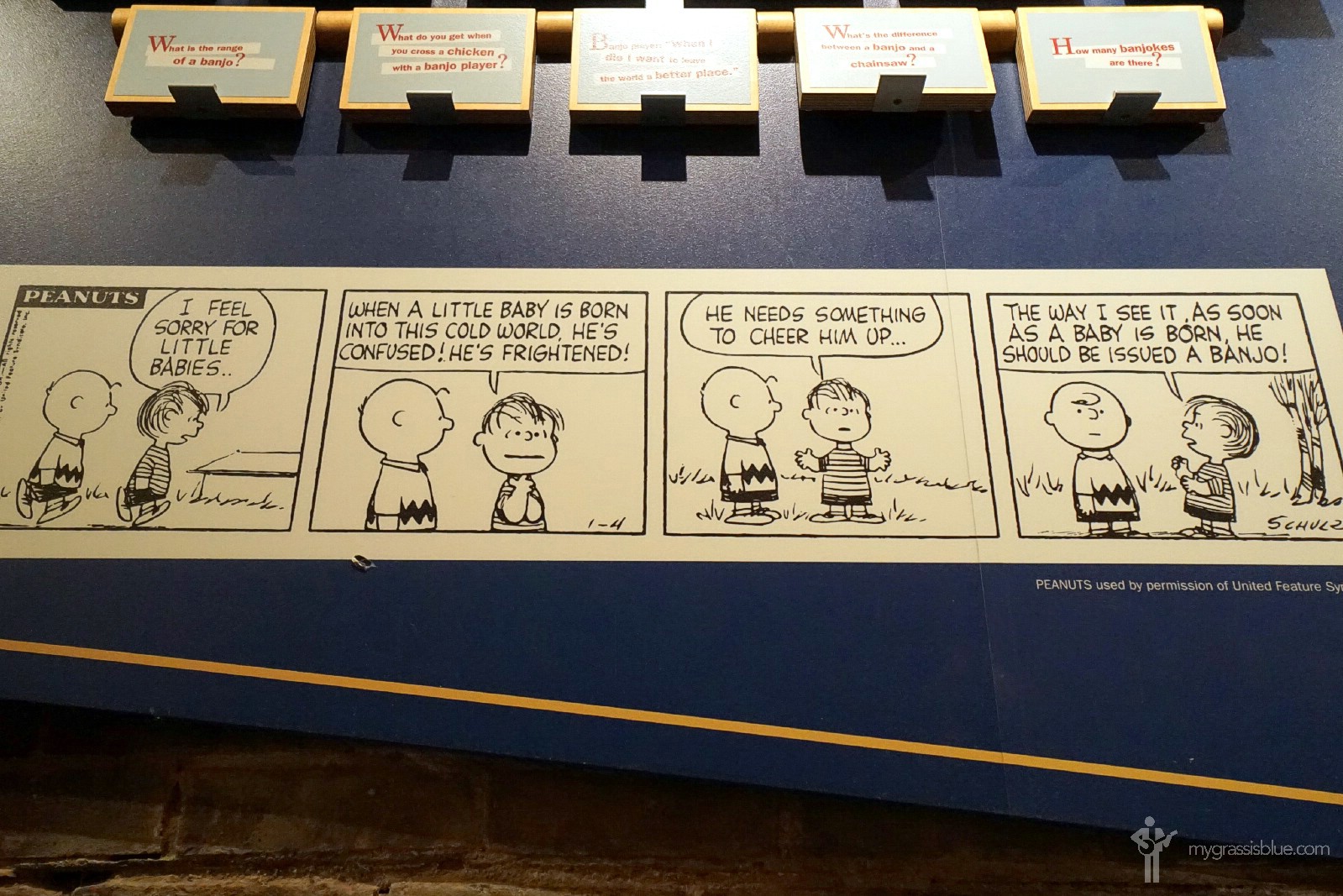
‘BANJOKES‘ | Bluegrass Music Hall of Fame & Museum, Owensboro, KY. September 28, 2016.
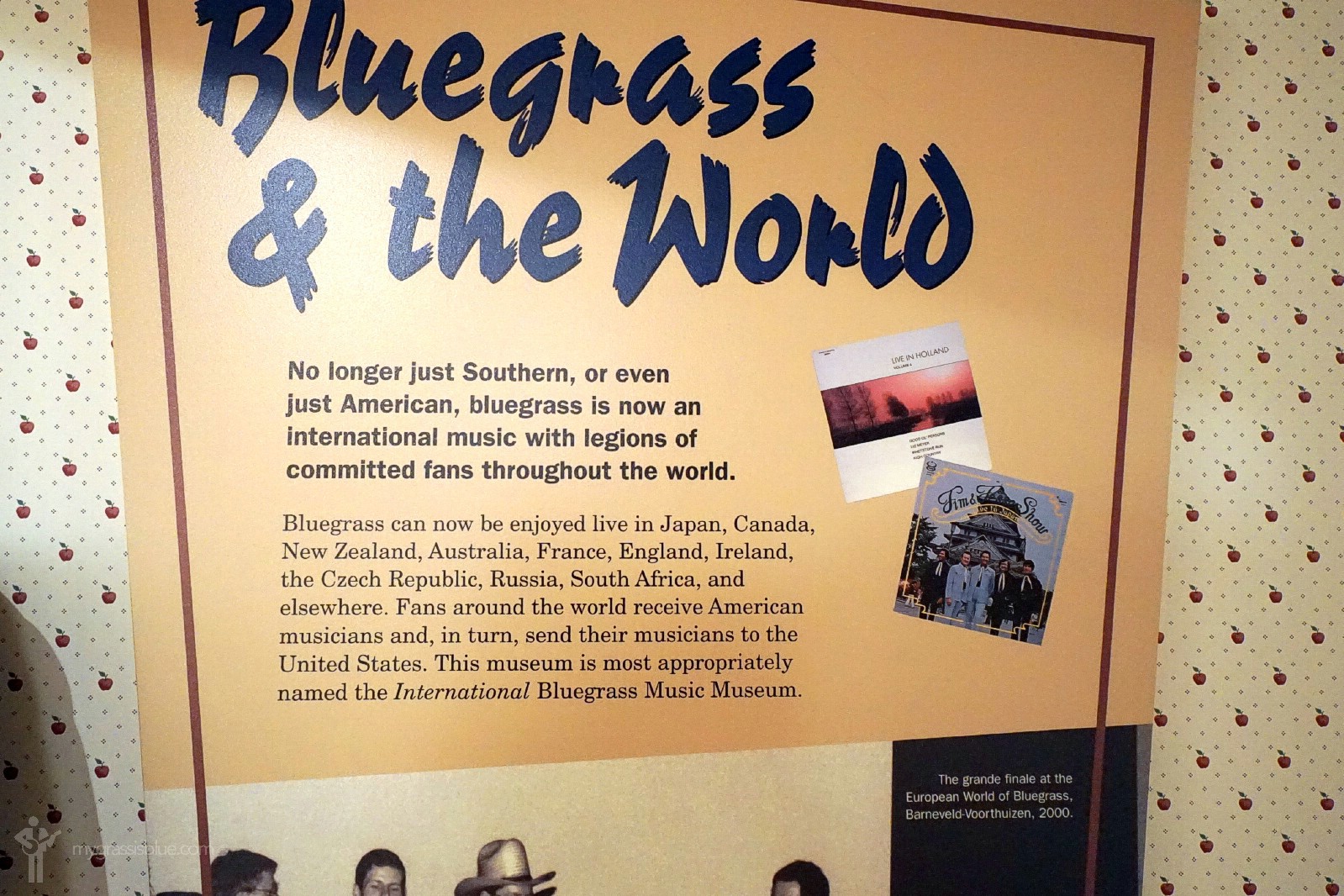
‘BLUEGRASS & THE WORLD‘ | The ‘Bluegrass & The World’ display in the then International Bluegrass Music Museum, Owensboro, KY. September 28, 2016.
HALL OF FAME
– bluegrasshall.org
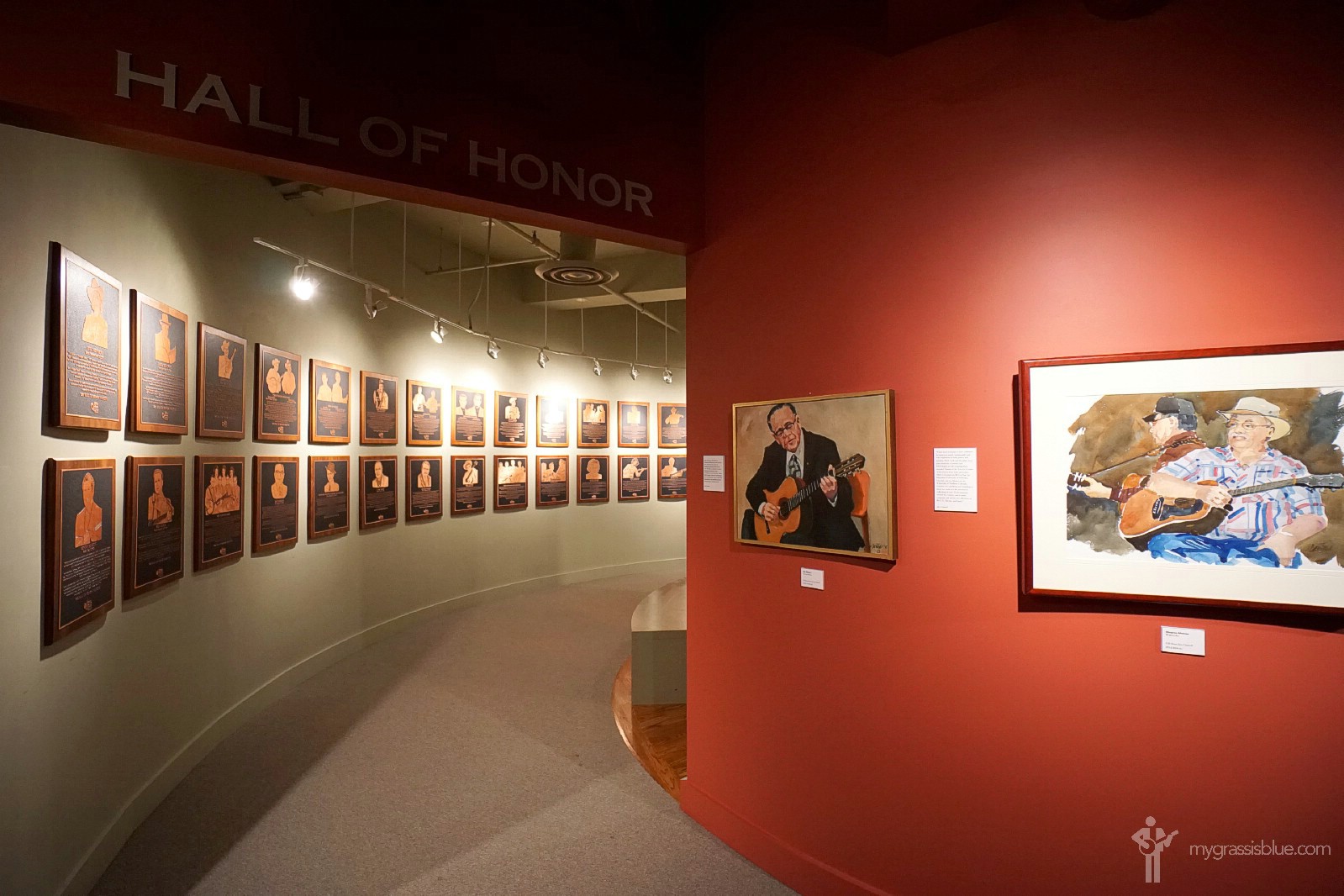
HALL OF FAME / HONOR | Outside the Hall of Honor of the old International Bluegrass Music Museum, Owensboro, KY. September 28, 2016.
A venerated space, ‘The crown jewel of the museum’ is how the museum itself describes its Hall of Fame inductee room, which went by the name Hall of Honor in the old museum, seen here. Displaying the bronze plaques of all Hall of Fame inductees, it’s a space designed to pay homage to the artists who ‘conceived, shaped and influenced this unique American art form’, the bluegrass music industry’s tribute to the pioneers of the music and the people who have made it as great as it is. You could spend a lot of time in here hopping from plaque to plaque. But don’t worry if time — or fatigue — catches up on you – all bios are posted to the awesome Inductees page of the museum’s website (see below) enabling you to peruse at your leisure and pay your respects at any time.
A lot has changed in the bluegrass scene in Owensboro since we were last in town. We’ve fond memories of the ‘old’ so we’re looking forward to getting back to experience the ‘new’ for ourselves.
Elsewhere | VIDEO
Bluegrass Music Hall of Fame & Museum Virtual Tours // Introduction & The Sources of Bluegrass Music (9 minutes 21 seconds) | Bluegrass Music Hall of Fame & Museum Executive Director Chris Joslin is very much front and centre here as he starts out by introducing both the museum and the genre of bluegrass. While the video is billed as a chronological scoot through the various areas of the museum, it in fact focuses only on the genre’s formation and early influences and is complemented by musical performances to boot. Way to go, Chris!
Bluegrass Music Hall of Fame & Museum Visitor Experience (4 minutes 04 seconds) | A promo video from the museum itself highlighting the museum experience with footage mostly shot on opening day in October 2018 and with input from Chris Joslin, Sam Bush, and Doyle Lawson, all of which comment on both the genre’s need for such a space given its growth and the ongoing support as afforded to the bluegrass community by the City of Owensboro. Thank you, Owensboro!
Bluegrass Music Hall of Fame & Museum ~ Music with a Mission (6 minutes 37 seconds) | A look from the museum itself at its own efforts to educate and teach the next generation of pickers as part of the museum’s vision to spread the joy of bluegrass throughout the community of Western Kentucky.
Bluegrass Music Hall of Fame & Museum tour (5 minutes 47 seconds) | More false advertising. Not really much of a ‘tour’, more a look by the Owensboro Times at some of the familiar-looking exhibits of the new museum prior to it’s opening in October 2018. Again Chris Joslin makes an appearance (from 4:35).
MainStreet – “The International Bluegrass Hall of Fame and Museum” (6 minutes 17 seconds) | This WKU PBS ‘MainStreet’ presentation from 2018 takes a look at the old museum with commentary from the then museum’s Promotions Director Chris Langdon, who gives not only an overview of the formation and growth of the museum and it’s Hall of Honor/Fame, but also an enthusiastic overview of the formation of the bluegrass genre itself. Chris closes out the video with statement that ‘there’s something in bluegrass that’ll catch your ear’, promptly followed by a warning that ‘you should probably watch out because it’ll hook ya.’ Ain’t that the truth.
Elsewhere | ONLINE
The Bluegrass Music Hall of Fame & Museum‘s very own home on the internet is an obvious first port of call for information on all things bluegrass music museum and Hall. Don’t miss the site’s ‘Inductees‘ page with in-dept bios and titbits on all Hall of Fame inductees.


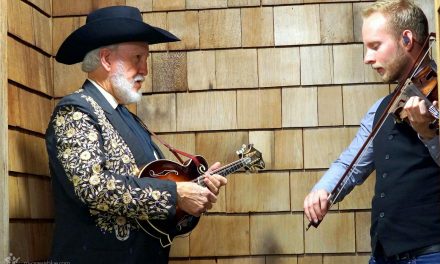
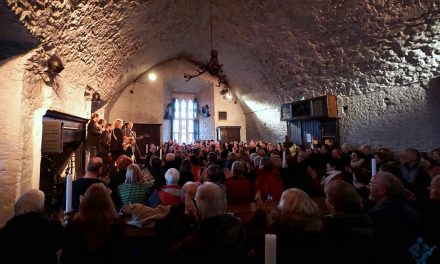
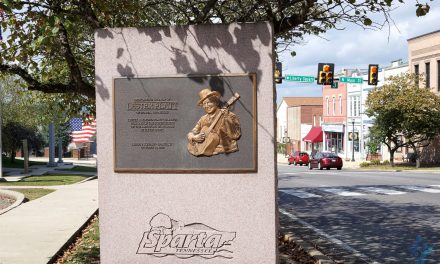
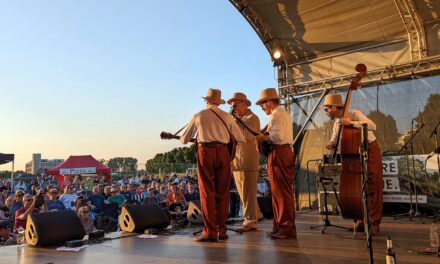

0 Comments